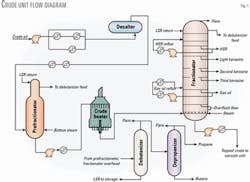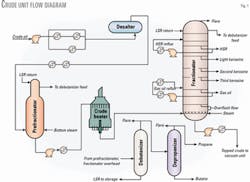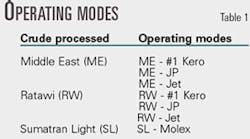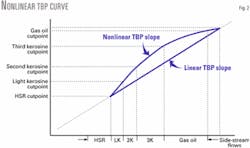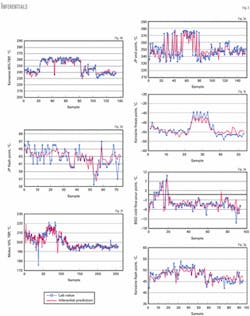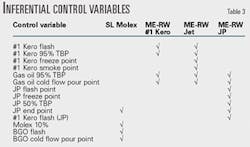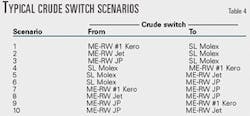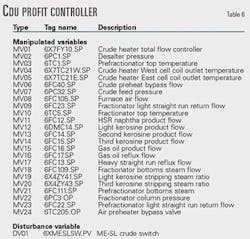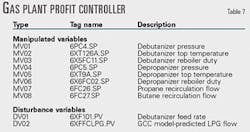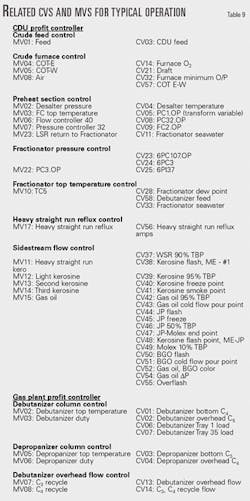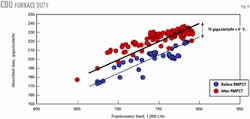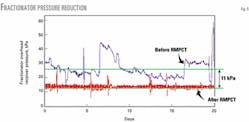At yearend 1998, Koa Oil Co. (now part of Nippon Oil Corp.) embarked on a comprehensive advanced control implementation at its refineries in Marifu and Osaka. The advanced control implementation included multivariable controllers and optimizers in all the major process units in both refineries and a separate oil movements and blending optimization project.
Koa selected Honeywell Hi-Spec Solutions' Profit Suite for multivariable control. At the project's completion in mid-2001, 22 profit controllers (formerly robust multivariable predictive control technology [RMPCT] controllers) and two profit optimizers were installed at the two refineries. We estimate the benefit from all these applications at about $4 million/year.
This article specifically covers the multivariable controller implementation at the No. 4 crude unit at Marifu refinery and describes the major highlights of this application. The new control strategy reduced operator load for normal plant operations and crude switches.
Quantifiable benefits were nearly $600,000/year. We could not readily quantify a few additional benefits such as high-quality inferential control variables for crude products.
Marifu crude unit
The Marifu refinery No. 4 crude distillation unit (CDU) operates at a nominal feed capacity of 127,000 b/sd. The unit is divided into a crude section and a gas plant section (Fig. 1).
The crude section consists of two preheat trains on each side of a desalter, a prefractionator (FC), crude heater, and 52-tray crude fractionator. The gas plant section includes a 35-tray debutanizer column and a 40-tray depropanizer column.
Products from the prefractionator and fractionator include light (LSR) and heavy naphtha streams (HSR) that combine to form a wide-cut naphtha (WSR) product, a wide-cut naphtha stream sent to a catalytic reformer, three kerosine streams (light, second, and third), gas oil, and topped crude.
Prefractionator and fractionator overhead streams go to the gas plant where they are separated into butane and propane.
The crude unit operation is complex in two respects. First, there are many operational modes that require entirely different operating conditions. Second, the unit undergoes severe crude switches.
Operating mode complexities exist because the refiner can combine the three kerosine and gas oil side streams in various ways. There are different property specifications for the product streams in each operating mode.
Table 1 shows the most common crude types and operating modes, and Table 2 illustrates side stream combinations during the different modes.
The crude unit processes different crude slates with crude switches occurring every 2-5 days. Some of those switches are so severe that without advanced process control (APC) it takes a long time to line out the unit; this occasionally leads to incidents such as pump cavitation, off-specification products, and furnace overheating.
Multivariable controller objectives
The design stage defined these broad controller objectives:
Meet the unit feed target (controller never needs to maximize the throughput).
Maximize production of the most valuable products by minimizing product quality giveaways.
Maximize operational efficiency (maximize coil outlet temperature, minimize crude feed preheat bypass flows, etc.).
Preserve various process constraints.
Optimize crude switch handling by:
- Handling process constraints.
- Automating changes in quality targets and optimization objectives.
- Minimizing crude switching time.
Crude switch optimization is a major benefit of implementing the profit controller.
Design considerations
There were several major design considerations throughout the course of implementing the project.
Nonlinear crude model
A high-fidelity crude true boiling point (TBP) model was essential for development of accurate inferentials and handling crude switches. We chose a generalized cut-point control (GCC) model for this purpose.1
The GCC model is based on first-principle calculations such as heat balance and TBP-equilibrium flash vaporization conversions. The model does not require much tuning.
The model first calculates the fractionator naphtha cut point based on prefractionator overhead flow, fractionator top temperature, and partial pressure correction. Next, it calculates flash-zone vapor flow from a heat balance across the column. This is followed by a flash-zone cut point calculation based on flash-zone vapor flow, temperature, pressure, and steam flow.
The GCC model initially assumes a linear TBP curve between naphtha and flash-zone cut points. It then uses column temperature profiles to estimate nonlinearities. Finally, the nonlinear TBP curve is used to estimate the side- stream cut points.
Fig. 2 shows a plot of the side stream flows vs. the linear and nonlinear TBP cut points.
During a crude switch, the column can be out of mass balance for a long time but it cannot be out of heat balance. The GCC method is based on heat balance; therefore, it gives fairly accurate results for the cut-point predictions during crude switches.
The GCC model replaced an old crude TBP model, which had two inaccuracies:
- It ignored the prefractionator completely and considered the fractionator feed as crude. This led to errors when the prefractionator column operation changed.
- It did not consider TBP slope nonlinearity. The TBP curve for the Sumatran Light (SL) crude was significantly nonlinear.
Inferential control variables
We developed 15 inferentials for product properties using the GCC model. We input these inferentials to the profit controller as control variables (CVs). Overall, the inferential models were excellent.
The graphs in Fig. 3 show the comparison of inferentials with lab measurements for jet propellant (JP) end point, kerosine 95% TBP, kerosine freeze point, JP flash point, blended gas oil (BGO) cold flow pour point (CFPP), Molex 10% TBP, and kerosine flash point.
Predictions even from difficult inferences like flash point, CFPP, and freeze point were quite good; in nearly all the cases, a laboratory or analyzer bias update was unneeded, even though all the inferentials were used for online control.
All of the inferential properties except for the cold properties (e.g., freeze point) were based on side stream cut points. Cold properties required an additional density measurement using a Watson K factor.
We developed inferentials for the product side streams for each of the crude types and operating modes. During crude switches, these CVs were dropped or brought in as per the product specifications (Table 3).
Size, scope of controller
Initially we thought that the CDU crude section and gas plant would reside in the same controller. We changed this to two controllers during detailed design, one for the CDU crude section and one for the gas plant. We made this design change because:
A smaller controller is easier to operate and maintain than a larger controller. The CDU section controller itself was quite large.
A single controller would require a model between CDU feed rate and debutanizer-depropanizer constraints. After step testing, we realized that for a single controller some of the models would have a settling time of almost 5 hr. In the crude section, the shortest responses were around 15 min. A combination of long and short settling times can reduce the control system's effectiveness.
We incorporated crude unit CVs in the gas plant controller and gas plant CVs in the crude unit controller to handle the interactions between the two controllers.
Quality estimation
The GCC model can continually estimate the crude TBP curve slope. New crude entering the crude column during a crude switch affects the heat balance and changes the TBP slope.
When the calculated TBP slope changes, the calculated TBP cut points and inferred product quality CVs also change. The multivariable controller can maintain CVs at target values during a crude switch due to fast responses between the side stream product flow manipulated variables (MVs) and inferred product quality CVs.
Timing between the TBP slope update and resulting multivariable controller manipulations is exact. The calculation does not have to lead or lag because the change in heat balance occurs exactly in phase with the change in column vapor flow.
While the crude switch progresses and the crude TBP slope transitions to a new value, the multivariable controller continues simultaneously to manipulate the side-stream product flows to maintain product qualities.
Crude switch handling
After achieving a good estimation of product properties through crude switches, we were faced with the challenge of moving the unit fast enough to control those properties and not violate unit constraints.
Large multivariable controllers are generally not tuned aggressively enough to move the unit quickly; we needed to implement that ability by adding disturbance variables (DVs) and gain scheduling.
Additionally, we wanted to incorporate features to move the unit smoothly through mode switches during the crude switches.
Table 4 shows the crude switches designed into the controller.
We developed a crude-switching program that was implemented in the distributed control system (DCS). The program works in conjunction with the multivariable controller and automates almost all of the required operator actions. The program:
- Turns certain CVs on and off, depending on the crude-switch type.
- Changes optimization coefficients.
- Changes the high and low limits of certain CVs and MVs.
- Changes product rundown valves.
- Changes analyzer sampling points.
The operator only has to select the type of crude switch, set the various targets, and start the crude-switching program.
Crude-switch DV
The Middle East (ME)-SL and SL-ME crude switches were particularly severe. We decided to use a crude switch DV in these cases. The ME-Ratawi (RW) and RW-ME switches were not severe and the built-in robustness of the controller was sufficient to handle them.
The crude-switch DV was triggered automatically when the crude preheat temperature (6TI31) crosses a certain temperature (45° C.). Since heavy crudes are hotter, crossing the 45° C. point indicates a heavy crude.
We obtained the DV models by regressing the data from several past crude switches. Some of the DV models included flow CVs: crude unit feed (CV03) and debutanizer feed (CV58). These flows undergo a significant change during a crude switch due to differences in crude characteristics.
Other DV models included desalter inlet temperature (CV04) and desalter pressure control output (CV05). These variables were primarily affected due to differences in crude feed temperatures.
The crude switch DV was successful because changes during crude switches were significant and predictable and because there was a good indicator (preheat temperature) for detecting the crude switch event.
Gain scheduling
We had to introduce gain scheduling in some cases to account for model nonlinearity (Table 5). A DCS program based on the current values of respective CVs and MVs implemented the automatic gain scheduling.
null
Design; typical operations
The design required us to define the MVs, DVs, optimization strategy, and typical operations.
MVs and DVs
Tables 6 and 7 show a full list of MVs and DVs for both controllers. Although the CVs are not listed in order to keep the list short, key CVs are mentioned elsewhere in the article.
Some important findings from Table 6 include:
•The existing total unit feed, 6FC1M (CV), was a very noisy signal. Instead, we used a new tag based on prefractionator overhead flow and furnace feed.
•The desalter pressure controller output (CV) was transformed using an equal percent-type valve equation.
•Two additional constraints for the controller were the side-stripper levels for the second and third kerosine streams. We provided this control outside the profit controller due to fast responses of side-stripper levels. We implemented a custom DCS code that reduces the side-stream flow if the level goes too low.
In Table 7, we replaced the old top temperature controllers for the debutanizer and depropanizer with pressure-compensated temperature controllers and used them as profit controller MVs.
Optimization strategy
We developed the optimization strategy based on discussions with operations, planning, and unit engineers. For the multivariable controller, configured cost coefficients on the CVs and MVs satisfied this optimization strategy.
Some of these cost coefficients change, depending on the type of crude and operating mode.
The numerical values of cost coefficients were based on trial and error to achieve the desired objective.
The CDU profit controller had these objectives:
- Maximize CDU feed as desired by the planner.
- Minimize CDU feed bypasses (to maximize heat exchange between the colder crude unit feed and hotter flow streams such as fractionator bottoms flow and side stream flows).
- Maximize prefractionator overhead flow.
- Maximize prefractionator bottom steam.
- Maximize furnace coil outlet temperatures (COTs).
- Minimize fractionator pressure.
- Minimize flaring from the fractionator blower (PC107).
- Maximize fractionator bottom steam.
- Maximize HSR reflux.
- Minimize light kerosine.
- Maximize gas oil.
- Minimize topped crude.
- Minimize light kerosine stripping steam.
- Minimize third kerosine stripping steam.
- Minimize gas oil stripping steam.
- Minimize prefractionator LSR return.
- Minimize fractionator LSR return.
For the MVs in Table 8, the optimization strategy was different for the various operating modes.
We programmed the gas plant profit controller to:
- Minimize debutanizer and depropanizer pressure.
- Minimize depropanizer duty.
- Minimize debutanizer duty.
- Minimize C3 circulation.
- Minimize C4 circulation.
Typical operating scenario
Although several models exist between all the MVs and CVs, MVs usually move due to a small set of CVs.
In fact, one can break down the whole controller into several small sets of CVs and MVs that act like subcontrollers for normal operations (95% of the time).
During occasional disturbances or unusual operations, the other models (CV-MV relationships) come into play.
Table 9 shows the type of controller subdivision that is useful for explaining and understanding controller behavior.
Benefits
We conducted a benefit study after several months of stable operation following the controller commissioning.
CDU furnace duty
CDU furnace absorbed duty (Fig. 4) increased due to:
- The ability to operate at a higher COT through tighter O2 control (CV) and optimum airflow (MV) manipulation.
- The ability to operate at a higher COT by pushing against the pass flow minimum output constraint.
- Lower column pressure.
Higher absorbed duty leads to better fractionation, which improves gas-oil yield. This benefit was about $400,000/year.
CDU fractionator pressure
The refiner could operate the CDU fractionator at a lower pressure (Fig. 5) due to:
•A better control handle. The profit controller manipulated the pressure controller output (6PC3.OP) instead of 6PC3.SP.
The pressure control was previously poor because of nonlinear behavior due to split-range operation. Control significantly improved (Fig. 5) due to a direct control handle (pressure valve output) and gain scheduling to account for any nonlinearity.
•Better constraint control. Pressure was minimized while satisfying the constraints for these CVs:
- Fractionator pressure 6PC3.PV.
- Receiver pressure 6PI37.PV.
- Blower suction pressure output 6PC107.OP.
The operator previously ran at a conservatively higher pressure to handle the constraints manually. Fractionation and, therefore, gas-oil recovery improved as a result of lower-pressure operation. This benefit was about $175,000/ year.
Better overflash control
The new controller attained better overflash flow control because:
- The operator could directly control overflash flow, a CV.
- Overflash CV was now based on a combination of flowmeter and calculated flow from GCC model.
This was helpful because the overflash flowmeter reading often went out of range.
This sometimes helped maximize gas oil flow during JP operation. We did not calculate this benefit.
Gas plant flexibility
The operator now had more flexibility to regulate debutanizer bottoms %C4.
For example, the operator can either minimize %C4 in the debutanizer bottoms by operating close to flooding (this was not possible before) or set a target for %C4 based on product specifications.
Improved crude switches, CDU
Before installing the new controller, the operator had to perform these actions manually during a crude switch:
•Initially choose or guess the correct TBP cut-point set points depending on crude type and desired product specification. Then make small adjustments to get the right product quality. The new application does this automatically based on 15 inferential CVs.
•Manipulate the fractionator side stream flows to control overflash and gas-oil DP. This is the pressure drop in the gas oil section of the fractionator and is an important indicator of the onset of fractionator flooding. The new controller does this automatically because overflash and gas-oil DP are CVs. There is also a crude switch DV for gas-oil DP.
•Manipulate furnace feed rate to achieve the correct CDU feed target. The new controller does this automatically because CDU feed is a CV and it also has a crude switch DV model.
•Manually increase COT while observing oxygen and gas-oil DP during a crude switch. The new controller does this automatically because it has these CVs in addition to a DV model.
Improved crude switches, gas plant
The new controller has several features to handle crude switches in the gas plant:
•Debutanizer feed DV. The debutanizer feed changes significantly during a crude switch; this DV gives advance information to the controller before the disturbance hits the column.
•LPG in debutanizer feed DV. The GCC model calculates LPG in debutanizer feed and, similar to the debutanizer feed DV, gives advance information to the controller.
•Debutanizer overhead flow CV. During some crude switches the debutanizer overhead flow drops too low. This CV allows flow control by manipulating the recycle flow MVs.
Crude switching requires almost no action by the operator with the new controller. The operator previously had to perform several actions during crude switches:
- Ramp set points for debutanizer bottoms rvp and overhead C5 control.
- Adjust debutanizer and depropanizer duties.
- Adjust the fractionator overhead temperature to prevent overloading the debutanizer.
Minimum light kerosine flow
Fig. 6 shows that the light kerosine flow was minimized with the new controller.
This results in more heat recovery in the crude preheat section because light kerosine does not exchange heat, unlike the second kerosine and third kerosine streams. This also leads to improved fractionation. We did not calculate this benefit.
Better constraint handling
The multivariable controller could easily handle many more constraints vs. the earlier regulatory schemes. This resulted in:
•Better optimization. The new controller does a better job vs. the operator of pushing CVs to their limits because it controls all the CVs every minute.
•Reduced operator load. Almost all the possible constraints were built in to the controller as CVs including the variables that only constrain occasionally.
Table 10 lists the "new" constraints (CVs) that the controllers handled.
Reference
- Friedman, Y.Z., "Control of crude fractionator product qualities during feedstock changes by use of a simplified heat balance," American Control Conference, Boston, June 1985.
The authors
Pradeep Singh is a senior advanced control specialist with Laplace Technologies Inc., Houston. He was previously the APC advisor at Koa Oil Co., Japan. Before that he worked for Exxon, Singapore Aromatics, where his responsibilities included implementation of advanced and multivariable control applications. Singh has more than 11 years' experience in advanced control and process engineering. He holds an MS in chemical engineering from the University of California, Los Angeles.
Tsutomu Hiroshima is a process control engineer at Koa Oil Co., Marifu, Japan, responsible for FCC, crude, and vacuum unit APC (MVC) implementation. He has more than 10 years' experience in process engineering and process control engineering. Hiroshima holds a masters (1991) in chemical engineering from Hokkaido University, Japan.
Kazuyuki Kakinoki is a process operations engineer at Koa Oil Co., Marifu, Japan, responsible for FCC, crude, and vacuum unit operations, optimization, and APC (MVC) implementation. He has more than 20 years' experience in these areas. Kakinoki has completed the mechanical engineering course of Iwakuni Technical High School, Japan.
Paul Williams is a senior application engineer for ExxonMobil, Fawley, UK. Previously he was a consultant for Honeywell Hi-Spec Solutions, UK, where he was responsible for the implementation of multivariable predictive control on 10 crude and vacuum units. He has more than 10 years' experience in advanced control and process engineering. He holds a masters in chemical engineering (1991) from University of Nottingham, UK.
Y. Zak Friedman is a principal consultant in advanced process control and online optimization with Petrocontrol, New York. He has more tan 30 years' experience in the hydrocarbon industry, working with Exxon Research & Engineering, KBC Advanced Technology, and for the past 10 years with Petrocontrol. He holds a BS from the Israel Institute of Technology (Technion), and a PhD from Purdue University.
